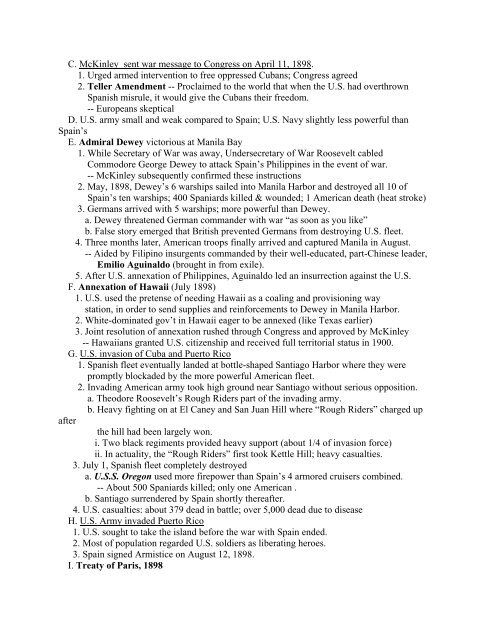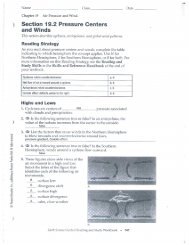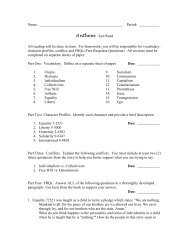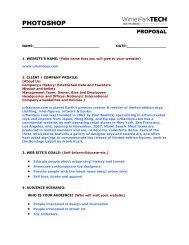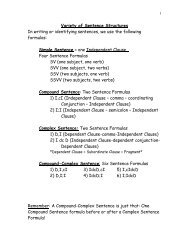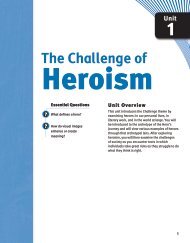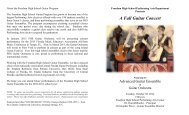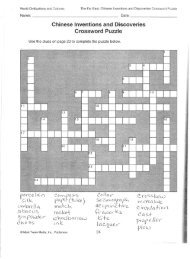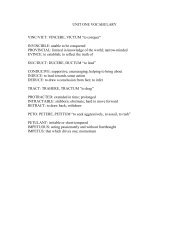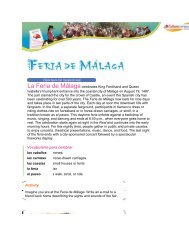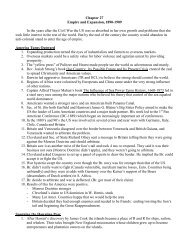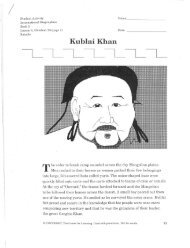Imperialism Notes 1890-1913
Imperialism Notes 1890-1913
Imperialism Notes 1890-1913
You also want an ePaper? Increase the reach of your titles
YUMPU automatically turns print PDFs into web optimized ePapers that Google loves.
C. McKinley sent war message to Congress on April 11, 1898.<br />
1. Urged armed intervention to free oppressed Cubans; Congress agreed<br />
2. Teller Amendment -- Proclaimed to the world that when the U.S. had overthrown<br />
Spanish misrule, it would give the Cubans their freedom.<br />
-- Europeans skeptical<br />
D. U.S. army small and weak compared to Spain; U.S. Navy slightly less powerful than<br />
Spain’s<br />
E. Admiral Dewey victorious at Manila Bay<br />
1. While Secretary of War was away, Undersecretary of War Roosevelt cabled<br />
Commodore George Dewey to attack Spain’s Philippines in the event of war.<br />
-- McKinley subsequently confirmed these instructions<br />
2. May, 1898, Dewey’s 6 warships sailed into Manila Harbor and destroyed all 10 of<br />
Spain’s ten warships; 400 Spaniards killed & wounded; 1 American death (heat stroke)<br />
3. Germans arrived with 5 warships; more powerful than Dewey.<br />
a. Dewey threatened German commander with war “as soon as you like”<br />
b. False story emerged that British prevented Germans from destroying U.S. fleet.<br />
4. Three months later, American troops finally arrived and captured Manila in August.<br />
-- Aided by Filipino insurgents commanded by their well-educated, part-Chinese leader,<br />
Emilio Aguinaldo (brought in from exile).<br />
5. After U.S. annexation of Philippines, Aguinaldo led an insurrection against the U.S.<br />
F. Annexation of Hawaii (July 1898)<br />
1. U.S. used the pretense of needing Hawaii as a coaling and provisioning way<br />
station, in order to send supplies and reinforcements to Dewey in Manila Harbor.<br />
2. White-dominated gov’t in Hawaii eager to be annexed (like Texas earlier)<br />
3. Joint resolution of annexation rushed through Congress and approved by McKinley<br />
-- Hawaiians granted U.S. citizenship and received full territorial status in 1900.<br />
G. U.S. invasion of Cuba and Puerto Rico<br />
1. Spanish fleet eventually landed at bottle-shaped Santiago Harbor where they were<br />
promptly blockaded by the more powerful American fleet.<br />
2. Invading American army took high ground near Santiago without serious opposition.<br />
a. Theodore Roosevelt’s Rough Riders part of the invading army.<br />
b. Heavy fighting on at El Caney and San Juan Hill where “Rough Riders” charged up<br />
after<br />
the hill had been largely won.<br />
i. Two black regiments provided heavy support (about 1/4 of invasion force)<br />
ii. In actuality, the “Rough Riders” first took Kettle Hill; heavy casualties.<br />
3. July 1, Spanish fleet completely destroyed<br />
a. U.S.S. Oregon used more firepower than Spain’s 4 armored cruisers combined.<br />
-- About 500 Spaniards killed; only one American .<br />
b. Santiago surrendered by Spain shortly thereafter.<br />
4. U.S. casualties: about 379 dead in battle; over 5,000 dead due to disease<br />
H. U.S. Army invaded Puerto Rico<br />
1. U.S. sought to take the island before the war with Spain ended.<br />
2. Most of population regarded U.S. soldiers as liberating heroes.<br />
3. Spain signed Armistice on August 12, 1898.<br />
I. Treaty of Paris, 1898


